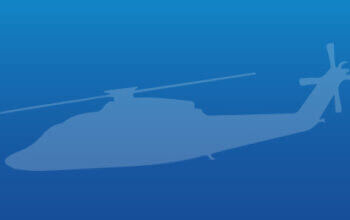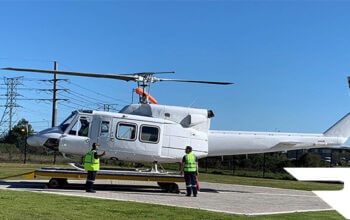Northern Airborne Technology Ltd. (NAT) is pleased to announce the new Digital Audio Control System (DACS), an intercom system designed for light twin, medium and heavy helicopters.
DACS is a communications management system with the ability to distribute and control all audio in an aircraft, to/from all transceivers, receivers and audio warning sources. The integrated, multichannel intercom system and programmable user definition allow the audio system to be configured to suit customer specific communication schemes.
The major components in the system are Audio Control Panels (ACP51, ACP53, ACP54), Audio Management Unit (AMU50), Remote Memory (RM01) and optional Passenger Intercom Amplifier (PIA01). The primary component in the system is the Audio Management Unit. Connected to it are transceivers (up to eight), receivers (up to eight), Direct Audio inputs (up to 6), Audio Control Panels (up to six) and one Passenger Intercom Amplifier. The Audio Management Unit distributes all radio audio to each user and to the Passenger Intercom Amplifier. Seven headsets can be connected to the Audio Management Unit (basic configuration is two crew and five passengers). Each passenger headset can also be assigned to a specific ACP, upgrading the passenger to a fully capable crewmember. More than one headset can be assigned to an ACP. The system architecture is a ‘star’ configuration (separate serial connections to each Audio Control Panel and Passenger Intercom Amplifier) to prevent loss of the entire system because of a failure of one connection.

Three types of audio control panels are available, all Dzus mounted, one designed specifically for 7 RT’s and the other two for 8 RT’s. All control panels have individual volume controls with push button selection for each receiver input. The audio control panels are ?terminals’ that monitor switch selections and provide system status indicators, while communicating with the Audio Management Unit over separate serial data buses. All audio processing is completed in and all audio connections are made to the Audio Management Unit, reducing installation costs, weight and complexity, while offering improved performance. The Passenger Intercom Amplifier is a remote mounted unit capable of connecting up to twelve additional passengers to the audio communications system. The Passenger Intercom Amplifier provides intercom audio for the passengers and communications with the Audio Control Panel users in the rest of the system. Legacy intercom units (eg. AA38, AA82, etc.) can also be connected to the AMU50.
The system’s flexibility allows the DACS to be easily configured to support customer requirements on a per installation basis. Two new product concepts are utilized to provide maximum flexibility and customization without making any changes to the hardware. The first is the Configuration Management Software (CMS) and the second is the use of ?snap-in’ radio legends. The CMS allows the user to define the number of radios, number and type of users associated with each ACP, headset impedances, VOX control for the passengers, input/output levels for the transceivers and receivers, and numerous other system options. The ?snap-in’ legends allow the OEM and/or installing agency to order standard ACP’s and still be able to customize the radio legends to best suit the com/nav package on the aircraft.
Today’s aircraft have many warning/advisory signals that need to be heard by the flight crew. Older audio systems are usually limited in the number of warning signals that can be supported, which can become costly integration issues. The DACS has been designed with the modern cockpit in mind, providing six direct (unswitched) audio inputs. These inputs are fixed gain type, but can have the gain adjusted using the CMS. Selection of the direct audio inputs is defined by way of the CMS. DACS also has an integrated aural warning generator, providing eight tone/voice warnings with multiple levels of priority. The CMS allows the customer to load predefined voice/tone warnings or their own warning messages (.WAV files) and set the priority associated with each of the eight warnings.
Compared to an analog audio system, the DACS provides a much simplified installation, improved performance (configurable, more features, reduced crosstalk, higher immunity to noise, etc.), reduced installation and maintenance costs, and a large weight savings.
A member of the Cobham Avionics and Surveillance division, NAT is a leader in communications equipment for special mission aircraft applications. Products include Audio and RF Controllers, FM Radios, Intercoms, PA and Loudhailer Systems, Satellite Communication Systems and Data Interface Accessories.
For further information, visit www.northernairborne.com or contact Ray Lewis, VP, Business Development, tel: (250) 763-2232 / (888) 763-2232, fax: (250) 762-3374, or e-mail rayl@natech.com.








